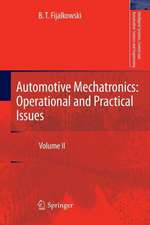Spatial Kinematic Chains: Analysis — Synthesis — Optimization
Autor Jorge Angelesen Limba Engleză Paperback – 18 apr 2012
Preț: 647.27 lei
Preț vechi: 761.49 lei
-15% Nou
Puncte Express: 971
Preț estimativ în valută:
123.87€ • 128.85$ • 102.26£
123.87€ • 128.85$ • 102.26£
Carte tipărită la comandă
Livrare economică 14-28 aprilie
Preluare comenzi: 021 569.72.76
Specificații
ISBN-13: 9783642488214
ISBN-10: 3642488218
Pagini: 384
Ilustrații: XII, 370 p.
Dimensiuni: 170 x 244 x 20 mm
Greutate: 0.61 kg
Ediția:Softcover reprint of the original 1st ed. 1982
Editura: Springer Berlin, Heidelberg
Colecția Springer
Locul publicării:Berlin, Heidelberg, Germany
ISBN-10: 3642488218
Pagini: 384
Ilustrații: XII, 370 p.
Dimensiuni: 170 x 244 x 20 mm
Greutate: 0.61 kg
Ediția:Softcover reprint of the original 1st ed. 1982
Editura: Springer Berlin, Heidelberg
Colecția Springer
Locul publicării:Berlin, Heidelberg, Germany
Public țintă
ResearchCuprins
1 Mathematical Preliminaries.- 1.0 Introduction.- 1.1 Vector space, linear dependence and basis of a vector space.- 1.2 Linear transformation and its matrix representation.- 1.3 Range and null space of a linear transformation.- 1.4 Eigenvalues and eigenvectors of a linear transformation.- 1.5 Change of basis.- 1.6 Diagonalization of matrices.- 1.7 Bilinear forms and sign definition of matrices.- 1.8 Norms, isometries, orthogonal and unitary matrices.- 1.9 Properties of unitary and orthogonal matrices.- 1.10 Stationary points of scalar functions of a vector argument.- 1.11 Linear algebraic systems.- 1.12 Numerical solution of linear algebraic systems.- 1.13 Numerical solution of nonlinear algebraic systems.- References.- 2. Fundamentals of Rigid-Body Three-Dimensional Kinematics.- 2.1 Introduction.- 2.2 Motion of a rigid body.- 2.3 The Theorem of Euler and the revolute matrix.- 2.4 Groups of rotations.- 2.5 Rodrigues’ formula and the Cartesian decomposition of the rotation matrix.- 2.6 General motion of a rigid body and Chasles’ Theorem.- 2.7 Velocity of a point of a rigid body rotating about a fixed point.- 2.8 Velocity of a moving point referred to a moving observer.- 2.9 General motion of a rigid body.- 2.10 Theorems related to the velocity distribution in a moving rigid body.- 2.11 Acceleration distribution in a rigid body moving about a fixed point.- 2.12 Acceleration distribution in a rigid body under general motion.- 2.13 Acceleration of a moving point referred to a moving observer.- References.- 3. Generalities on Lower-Pair Kinematic Chains.- 3.1 Introduction.- 3.2 Kinematic pairs.- 3.3 Degree of freedom.- 3.4 Classification of lower pairs.- 3.5 Classification of kinematic chains.- 3.6 Linkage problems in the Theory of Machines and Mechanisms.- References.-4. Analysis of Motions of Kinematic Chains.- 4.1 Introduction.- 4.2 The method of Denavit and Hartenberg.- 4.3 An alternate method of analysis.- 4.4 Applications to open kinematic chains.- References.- 5. Synthesis of Linkages.- 5.1 Introduction.- 5.2 Synthesis for function generation.- 5.3 Mechanism synthesis for rigid-body guidance.- 5.4 A different approach to the synthesis problem for rigid-body guidance.- 5.5 Linkage synthesis for path generation.- 5.6 Epilogue.- References.- 6. An Introduction to the Optimal Synthesis of Linkages.- 6.1 Introduction.- 6.2 The optimisation problem.- 6.3 Overdetermined problems of linkage synthesis.- 6.4 Underdetermined problems of linkage synthesis subject to no inequality constraints.- 6.5 Linkage optimisation subject to inequality constraints. Penalty function methods.- 6.6 Linkage optimisation subject to inequality constraints. Direct methods.- References.- Appendix 1 Algebra of dyadics.- Appendix 2 Derivative of a determinant with respect to a scalar argument.- Appendix 4 Synthesis of plane linkages for rigid-body guidance.













